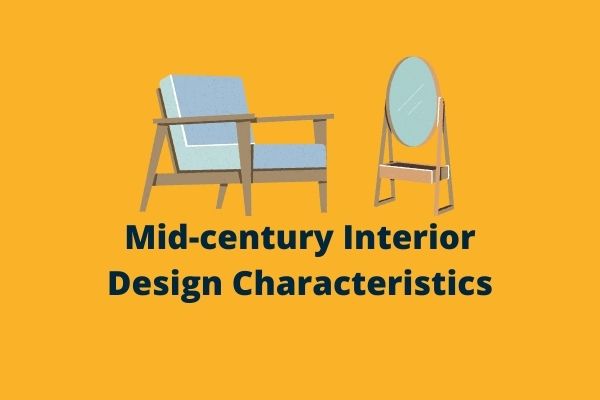Mid Century Modern Interior Design Characteristics – Medieval (mid-century) house designs are often viewed as too complex and not suitable for minimalist dwellings. However, this assumption can be discarded with a modern mid-century design that seems simpler without ignoring the aesthetic side. It is not surprising that this style of furnishing is very attractive to many people.
mid century modern interior design characteristics are based on many factors. It is characterized by clean lines, soft organic curves, and minimalism.
Mid-century modern interiors emphasize reduced forms, contemporary patterns, natural materials, and a seamless transition between indoor and outdoor spaces. Create the comfort of functional space with a chic appearance.
This design style looks nicer with clean upholstered furniture with smooth curves and geometric shapes.
The use of wood is also deliberately designed in mid-century interiors in order to create a balance between various new and high-tech innovations, with classic models creating a room atmosphere that corresponds to the modern lifestyle.
It turns out that bringing that mid-century modern design feel to the interior of your home is not a difficult thing. Let’s see the different traits and characters that you can give to your favorite home.
Daftar Isi
1. Dominated by warm colors
One of the hallmarks of a mid-century modern home is the choice of warm colors. Some of the most popular colors that represent mid-century living styles are olive green, orange, yellow, and mustard. But you can also upgrade it with certain color accents such as brown, black, gray and turquoise.
In medieval Europe, these colors can create the impression of a warm interior in winter as they reflect sunlight more effectively. However, there are currently many tropical residences that take on mid-century colors with certain adjustments.
2. Use a large window
Mid-century modern living spaces also use large windows. Large windows in European homes are used to maximize sunlight, especially in winter. So that the interior of the house remains as bright and warm as possible. In the meantime, large windows in tropical houses have a slightly different function, namely to facilitate air circulation so that the inside of the house feels cooler and not damp.
3. Use of sliding doors
Not only large windows but also modern living rooms in mid-century style appear spacious and open with sliding doors. The placement of the sliding door increases the freedom of movement in a room as it is attached to the wall. The sliding door can also make the house appear wider because it acts as a partition between the rooms, which can be opened and closed as required.
4. Prioritizing wooden elements in the room
Wood elements are also a design feature that cannot be separated from Mid-Century Modern. The use of wooden elements in the form of furniture or displays completes a solid impression in the room. In the past, the mid-century impression was given by heavy-looking hardwood furniture. Now, however, you can get around this by using processed wood (like plywood) so that the look of a mid-century room still looks modern.
5. Identical to brown furniture
Wood isn’t the only furniture material that can add strength to a mid-century modern design at home. You can also choose other brown furniture material variants such as leather, synthetic leather, or even synthetic rattan. The combination of contrasting colors between the furniture and the interior of the room creates a harmonious mid-century character.
6. Rely on lighting as a decorative element
Lighting is not only used for room lighting. Modern mid-century house designs also rely on lighting as a decorative element. This can be seen in the use of bubble lamps, floor lamps, or chandeliers with special shapes. These lights not only shine but can also be an indoor attraction that leaves a unique impression.
7. Create combinations of textures as features
Another mid century modern interior design characteristics is the combination of different textures. The combination of slightly crumpled linen, fibrous wool structure, or leather structure are elements that reinforce the mid-century impression. However, you have to make sure that the combination of textures still has to look harmonious so that the interior of the house does not look messy.
Over the years we have seen many innovations in interior design. Many new styles have been explored, especially the strengthening of the minimalist interior design concept that continues the modern style.
Apparently, however, the mid-century style is still the favorite choice of many homeowners. Not only residential, office and commercial spaces use this style as a leitmotif of the interior.
With the introduction of the spruce, the modern mid-century interior style grew in America based on earlier styles such as the Bauhaus, which began in Germany. However, the events of World War II interrupted the development of this interior design. It was also the war that emigrated many Bauhaus architects and designers to America due to the changes in Germany.
Like the war, economic change and technological progress also influence how we live, what we want and need.
After the Second World War, there was an expansion of cities and suburbs in the USA. At the same time, the demand for modern furniture for new modern homes that are built quickly, such as the Eichler House built in California by Josef Eichler, is growing.
Technological advances have also led to the creation and development of new materials that make it possible to explore new textures and effects, colors, and even new shapes.
Read Also : Minimizing The Use of Non-functional Elements with Minimalist Interior Design
